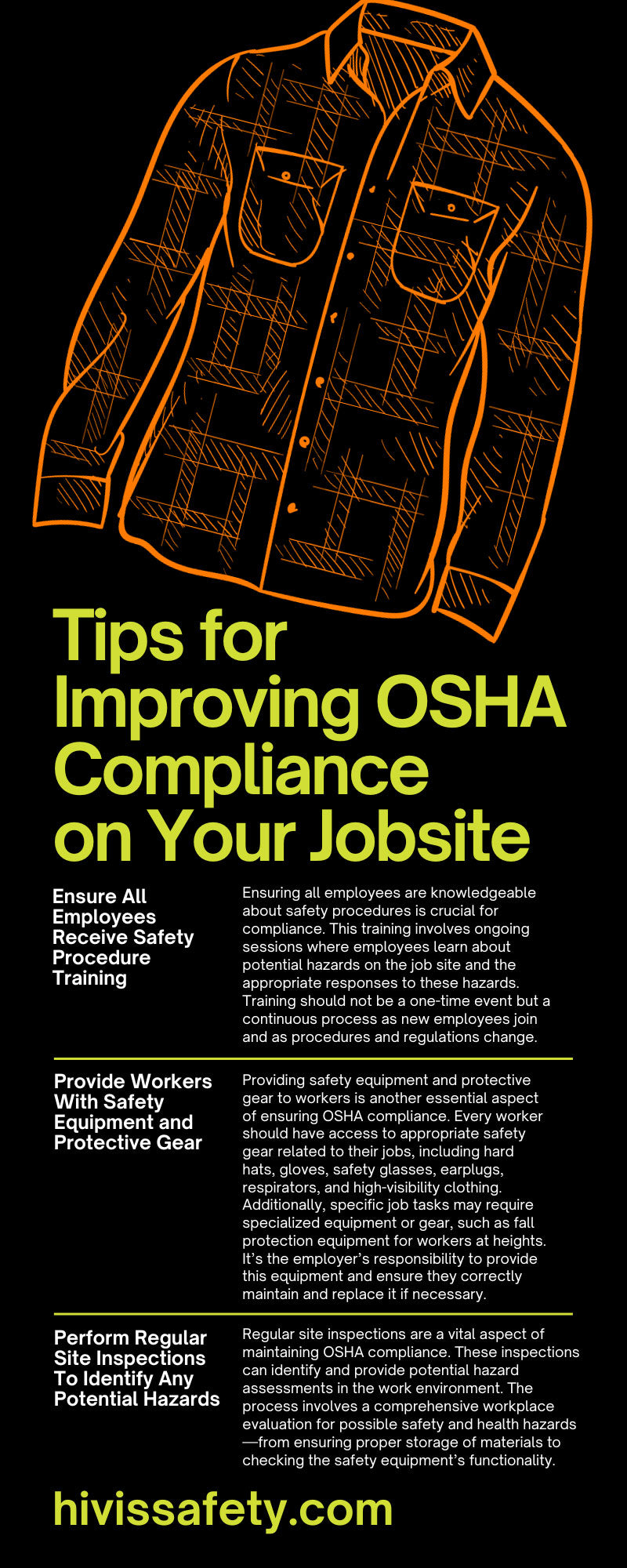
Safety should always be a priority on any job site. With the Occupational Safety and Health Administration (OSHA) setting forth regulations to ensure safe and healthy working conditions, companies must strive for strict compliance.
Here are seven tips for improving OSHA compliance on your job site to create a safer work environment for your employees.
Understand All Applicable OSHA Standards and Regulations
A complete understanding of all OSHA standards and regulations applicable to your industry is the first step toward achieving compliance. This knowledge forms the foundation for creating a safe working environment. OSHA provides a comprehensive list of standards based on the industry, which you can access on their official website. This list includes standards for General Industry, Construction, Maritime, Agriculture, and others.
It’s also important to keep up with recent updates or regulation changes. Ignorance of the rules cannot be an excuse for non-compliance. Employers must ensure they are fully informed and pass this information on to their employees through regular training sessions and safety briefings. This understanding allows for developing effective safety policies and procedures that adhere to OSHA standards.
Ensure All Employees Receive Safety Procedure Training
Ensuring all employees are knowledgeable about safety procedures is crucial for compliance. This training involves ongoing sessions where employees learn about potential hazards on the job site and the appropriate responses to these hazards. Training should not be a one-time event but a continuous process as new employees join and as procedures and regulations change.
Moreover, training needs to be specific to the job tasks of each employee to ensure maximum efficacy. It’s not sufficient for employees to only have a general understanding of safety procedures. They must fully comprehend the safety requirements of their specific roles and responsibilities.
Provide Workers With Safety Equipment and Protective Gear
Providing safety equipment and protective gear to workers is another essential aspect of ensuring OSHA compliance. Every worker should have access to appropriate safety gear related to their jobs, including hard hats, gloves, safety glasses, earplugs, respirators, and high-visibility clothing. Additionally, specific job tasks may require specialized equipment or gear, such as fall protection equipment for workers at heights. It’s the employer’s responsibility to provide this equipment and ensure they correctly maintain and replace it if necessary.
Proper safety gear fit and comfort are also important considerations to ensure workers wear them consistently. Training workers to correctly use the safety equipment can prevent injuries, illnesses, and accidents, ultimately fostering a safer workplace. Remember, investing in safety is an investment in your workforce’s well-being and productivity.
Perform Regular Site Inspections To Identify Any Potential Hazards
Regular site inspections are a vital aspect of maintaining OSHA compliance. These inspections can identify and provide potential hazard assessments in the work environment. The process involves a comprehensive workplace evaluation for possible safety and health hazards—from ensuring proper storage of materials to checking the safety equipment’s functionality. It is also important to inspect machinery and tools regularly to ensure they are in good working condition and do not pose any risk to the workers.
You should document these inspection findings and use them to implement corrective measures where needed. Regular site inspections help to identify potential hazards before they cause harm and demonstrate the employer’s commitment to maintaining a safe and healthy workplace. Hence, it should be part of the routine operations of any job site.
Provide Adequate Lighting, Ventilation, and Other Conditions
Maintaining adequate conditions, such as lighting and ventilation in the workspace, is a critical part of OSHA compliance. Proper lighting is essential for visual clarity and accident prevention due to poor visibility. High-quality illumination is necessary in areas where workers are performing detailed tasks or operating machinery. Similarly, adequate ventilation ensures a healthy work environment, especially in industries where workers are around airborne substances, dust, or high temperatures.
Providing fans, air conditioning, or heating systems and ensuring a steady fresh air flow can help maintain optimal working conditions. You should also consider other conditions, such as noise control, temperature management, and cleanliness. It’s the employer’s responsibility to ensure that the work environment is conducive to safety and health, improving worker productivity and satisfaction.
Ensure All Employees Understand Emergency Evacuation Procedures
Ensuring all employees understand emergency evacuation procedures is another key step toward OSHA compliance. Regular drills should help familiarize employees with the evacuation routes and assembly points. The procedures should be in visible locations across the workplace. You must also make accommodations for employees with disabilities to ensure their safe and swift evacuation alongside their coworkers.
Training sessions should include instructions on how to respond to different types of emergencies, such as fires or chemical spills, and the role of each employee during an emergency. Remember, in a crisis, preparedness can save lives. Thus, understanding and implementing emergency evacuation procedures is not just a compliance issue. It’s a matter of life and death.
Learn How To File the Necessary Paperwork in the Event of an Accident or Injury
In the unfortunate event of an accident or injury, understanding how to file the necessary paperwork to maintain OSHA compliance is crucial. Employers should be familiar with OSHA’s recordkeeping requirements, which necessitate the recording of all work-related illnesses and injuries. These requirements can include maintaining a log of injuries and illnesses (OSHA Form 300), a comprehensive incident report (OSHA Form 301), and a summary of work-related injuries and illnesses (OSHA Form 300A).
Moreover, you must report all severe work-related injuries directly to OSHA within specified time frames. Training employees on the importance of immediate injury reporting can help in accurate recordkeeping and ensure appropriate medical care. Understanding and observing these procedures meets compliance requirements and helps you to identify trends in accidents and know when to implement preventative measures.
Adhering to these seven tips for improving OSHA compliance on your job site can help you more effectively fulfill legal obligations and, more importantly, safeguard the health and safety of your employees on the job site. Each of the seven measures discussed contributes to an overall culture of safety. This culture, in turn, improves overall productivity and work satisfaction. Remember, a safe workplace is a productive workplace. Implement these tips to ensure OSHA compliance and create a healthier, safer job site for your employees.
Check out our extensive selection at Hi Vis Safety if you’re looking for quilted flannel shirts and other stylish, comfortable, and compliant PPE for your workplace. Shop with us today and improve the safety compliance on your job site.

